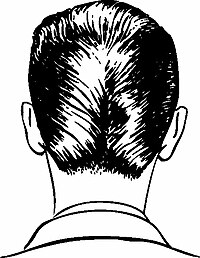Ducktail

The ducktail is a men's haircut style popular during the 1950s. It is also called the duck's tail, duck's ass, duck's arse, or simply D.A. and is also described as slicked back hair.[1][2] The hair is pomaded (greased), combed back around the sides, and parted centrally down the back of the head.
History
[edit]Joe Cirello, a barber from Philadelphia, said he had invented the duck's ass in 1940, and he called the swung hair sides and their termination 'The Swing', after the musical style of the day. He'd practiced on a lonely blind boy for about eighteen months.[3] The duck's tail became an emblematic coiffure of disaffected young males across the English-speaking world during the 1950s. In Britain, it formed part of the visual identity of teddy boys and rockers, along with the quiff and the elephant's trunk.
Combing technique
[edit]
The style required that the hair be combed back around the sides of the head.[4][5][6] The teeth edge of a comb was then used to define a central parting running from the crown to the nape at the back of the head, resembling, to many, the rear end of a duck. The hair on the top front of the head was either deliberately disarrayed so that untidy strands hung down over the forehead, or combed up and then curled down into an 'elephant's trunk' which would hang down as far as the top of the nose. The sides were styled to resemble the folded wings of the duck.
A variant of the style, the Detroit, consisted of the long back and sides combined with a flattop. In California, the top hair was allowed to grow longer and combed into a wavelike pompadour shape known as a "breaker".
The ducktail hair style contributed to the term greasers: to accomplish this look, much pomade (hair grease) was required to hold the hair in place. This was still the era of hair creams, so it only required an increase in the amount to make hair remain in the desired style. Brands of grease used include Black & White, Sweet Georgia Brown, Royal Crown, and Murrays. On the West Coast of the US, pomades such as Dixie Peach or Brylcreem, and tonics such as Wildroot Cream-Oil were popular.
To ensure that the hair was just so, the wearer often touched up the D.A. many times during the day by running his greased comb through it. This led to a stylized means of handling the comb by drawing it out of the back pocket of a pair of jeans using the extended index and middle finger, and, holding it thus, running the comb through the two side "wings" of the style to adjust their shape.
Significance
[edit]The D.A. quickly became a stereotypical feature of rebels, mobsters, and nonconformists, and gained popularity especially after the rise of rock 'n roll legend Elvis Presley, who sported the same look. Although the ducktail was adopted by Hollywood to represent the wild youth of the 1950s, only a minority of males actually sported a D.A., even amongst the British Rockers and Teddy Boys of the same era. The style became popular in India after film star Shammi Kapoor sported it. It is also associated with men of Mediterranean, Eastern European and/or Latin American descent, though in slightly different styles.
See also
[edit]References
[edit]- ^ Tom Dalzell (2009). The Routledge Dictionary of Modern American Slang and Unconventional English. p. 325. ISBN 9780415371827.
- ^ Victoria Sherrow (2006). Encyclopedia of Hair: A Cultural History. p. 194. ISBN 9780313331459.
- ^ Wallace, Andy (15 February 1994). "'Duck Cut' inventor Cirello, barber to stars dies at 79". Ocala Star-Banner. Retrieved 24 February 2014.
- ^ Farah Averill. "Slicked back: Timeless Hairstyles - AskMen". Uk.askmen.com. Retrieved 2016-07-17.
- ^ Valenti, Lauren (2015-06-04). "How to do a "Duck's Ass French Twist" in 5 steps". Cosmopolitan.co.uk. Retrieved 2016-07-17.
- ^ Megan Gustashaw (2015-11-28). "The Right (and Wrong) Way to Slick Back Your Hair". Gq.com. Retrieved 2016-07-17.
External links
[edit]- Illustration of a ducktail
 The dictionary definition of ducktail at Wiktionary
The dictionary definition of ducktail at Wiktionary
